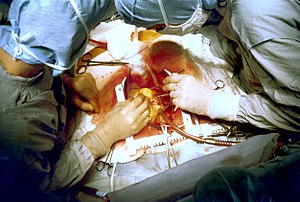 Image via Wikipedia
Image via Wikipedia
Heart Disease Facts
- Heart disease is the leading cause of death for both women and men in the United States.1
- In 2005, 652,091 people died of heart disease (50.5% of them women). This was 27.1% of all U.S. deaths. The age-adjusted death rate was 222 per 100,000 population.1
- Heart disease is the leading cause of death for American Indians and Alaska Natives, blacks, Hispanics, and whites. For Asians and Pacific Islanders, cancer is the leading cause of death (accounting for 27.5% of all deaths), heart disease is a close second (25.0%).2
- Heart disease crude death rates per 100,000 population for the five largest U.S. racial/ethnic groups are as follows: Hispanics, 69.2; Asians and Pacific Islanders, 73; American Indians, 82.5; blacks, 189.8; and whites, 235.5.2
- In 2005, the age-adjusted death rates for diseases of the heart was 211.1 deaths per 100,000 for all Americans. The age-adjusted death rate for whites was 207.8, and 271.3 for African Americans. Age adjusted rates are used to compare populations with differeing age distributions.2
- By state, age-adjusted death rates per 100,000 for diseases of the heart ranged from 141.1 (Minnesota) to 306.8 (Mississippi) in 2005.1
- Coronary heart disease is the principal type of heart disease. In 2005, 445,687 people that died from coronary heart disease. That is about 68.3% of all heart disease deaths.5
- It is estimated that about 47% of cardiac deaths occur before emergency services or transport to a hospital.4
- In 2009, heart disease is projected to cost more than $304.6 billion, including health care services, medications, and lost productivity.5
- Worldwide, coronary heart disease killed more than 7.6 million people in 2005.6
- Risk factors for heart disease among adults (for years 2003–2004 unless noted, age-adjusted):3
Percentage of persons aged 20 years and older with hypertension or taking hypertension medications: 32.1%
Percentage of persons aged 20 years and older with high blood cholesterol: 16.9%
Percentage of persons aged 20 years and older with physician-diagnosed diabetes: 10.0%
Percentage of persons aged 20 years and older who are obese: 32.0%
Percentage of adults aged 18 years and older who are current cigarette smokers (2004-2006): 18.4%
Percentage of adults aged 18 years and older who engage in no leisure-time physical activity (2006): 39.5%
- In 2003, approximately 37% of adults reported having two or more of six risk factors for heart disease and stroke (high blood pressure, high cholesterol, diabetes, current smoking, physical inactivity, and obesity).7
- Timely access to emergency cardiac care and survival is partly dependent on early recognition of heart attack symptoms and immediate action by calling emergency services. In a 2005 survey, most persons (92%) recognized chest pain as a heart attack symptom, but only 27% correctly classified all symptoms and knew to call 9–1–1 when someone was having a heart attack.8
- Studies among people with heart disease have shown that lowering high blood cholesterol and high blood pressure can reduce the risk of dying of heart disease, having a nonfatal heart attack, and needing heart bypass surgery or angioplasty.
- Studies among people without heart disease have shown that lowering high blood cholesterol and high blood pressure can reduce the risk of developing heart disease.
![Reblog this post [with Zemanta]](http://img.zemanta.com/reblog_e.png?x-id=d2f78067-4f9a-43b6-bb0f-915b3cd1ead1)



0 comentários
Postar um comentário